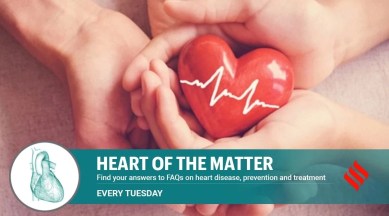Are you experiencing irregular heartbeats? What it tells you about your cardiac health
Arrhythmias can be caused by ageing, previous heart disease, high blood pressure, electrolyte imbalance and genetics. Sometimes they can be a crucial indicator of future events, says Dr Balbir Singh, Chairman, Cardiac Sciences, Cardiology, Cardiac, Electrophysiology-Pacemaker, Max Hospital

Often you may be halted in your tracks by a fluttering of the heart. This is because of irregular heart beats or what we call arrhythmia. Normally, the heart contracts very regularly between 60 to 120 seconds in resting and active phases but when this rhythm goes awry, we classify the condition as arrhythmia. This happens because the electrical signals that coordinate the heartbeats don’t work properly. The faulty signalling causes the heart to beat either too fast, which we call tachycardia, too slow, which we call bradycardia, or irregularly.
Sometimes, the fluttering can be harmless. Most of us have a fast or slow rate with different physical activities. For example, the heart rate may increase with intense exercise or slow down during sleep. However, sometimes arrhythmias can become serious — the heart beat becomes so chaotic that it is difficult for the body and organs to adjust their responses to this unruly pattern. And oxygenated blood may not be pumped in a manner it should to all parts of the body. That’s when a person needs an electric shock.
WHAT IS TACHYCARDIA?
If it’s tachycardia that one is suffering from, then one could be having one of the following:
(1) Atrial fibrillation or a condition when there is a rapid, uncoordinated heart rate. This may be temporary and pass over but should be treated to prevent serious episodes. This is common among Indians.
(2) Atrial flutter is similar but heartbeats are more organised, also linked to strokes.
(3) Supraventricular tachycardia is an arrhythmia that starts above the lower heart chambers (ventricles). It causes sudden pounding of the heartbeat that begins and ends without warning.
(4) Ventricular fibrillation occurs when rapid, chaotic electrical signals cause the lower heart chambers or ventricles to beat abnormally and can even lead to death if a normal heart rhythm isn’t restored within minutes. Usually, this happens in people with an underlying heart condition or trauma.
(5) Ventricular tachycardia happens when a rapid heart rate doesn’t allow the ventricles to properly fill with blood. So, the heart can’t pump enough blood to the body. May not affect healthy individuals as seriously as they do those with pre-existing heart conditions.
WHAT IS BRADYCARDIA?
If you have a slow heart rate when you are not at rest and your heart isn’t pumping enough blood, you may have a type of bradycardia. These include the following:
(1) Sick sinus syndrome or a condition where the sinus node is responsible for setting the pace of the heart. If it doesn’t work properly, the heart rate may vary. Happens in an ageing population where the nodes block electrical impulses.
(2) A conduction block in the heart’s electrical pathways can signal the heartbeats to slow down or stop.
(3) Premature heartbeats are extra beats that occur one at a time, sometimes in patterns that alternate with the normal heart beat. This is what we call the heart skipping a beat. Sometimes, it can be triggered by stress or stimulants.
WHAT CAUSES ARRHYTHMIA?
Arrhythmias can be caused by ageing, a history of heart disease, heart attacks, myocarditis or inflammation of your heart muscle, high blood pressure and sodium or potassium imbalances in your body. Sometimes arrhythmias are a consequence of a genetic disorder called Brugada syndrome, which can cause a dangerously irregular heartbeat, especially during sleep or at rest. It is now proven that mutations in the SCN5A gene (which creates sodium channels in the heart muscle cells) are responsible for this genetic condition, which manifests during sleep or rest and results in death, even in people with seemingly healthy hearts. This was the reason that for a long time nobody could diagnose how Thai young men died in their sleep because of their genetic trait. Brugada syndrome affects about five of every 10,000 people worldwide.
WHAT ARE SYMPTOMS?
Arrhythmias can be “silent” and show up only during a doctor’s reading or a test. When they do manifest as symptoms, they can take the shape of palpitations, unexplained chest thumping, dizziness, breathlessness, anxiety and exhaustion.
PREVENTION AND TREATMENT
Heart arrhythmia treatment may include medication, catheter procedures, implanted devices or surgery to control or eliminate fast, slow or irregular heartbeats. Otherwise, adherence to a heart-healthy lifestyle can eliminate the triggers for arrhythmias.
If you have symptoms, consult a cardiologist who may lead you to an electrophysiologist, who specialises in the science of heart beats. You will need to do an EKG, Holter, Echocardiogram and a stress test. And if you do not know yet if you need a cardiologist, monitor your heartbeat through the many wearable devices that can map your activity patterns and the corresponding heart rate. If you think there is something that’s out of range, consult a cardiologist to be sure.